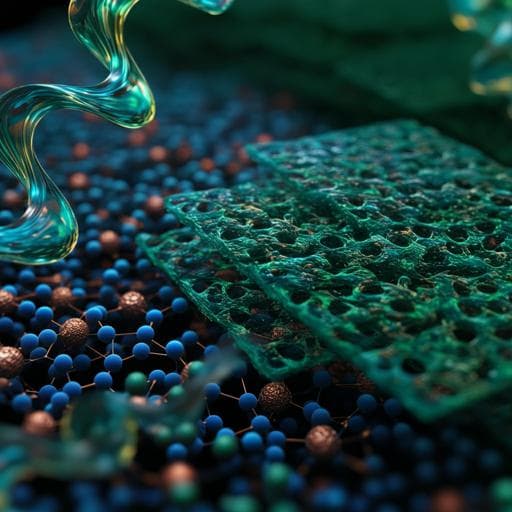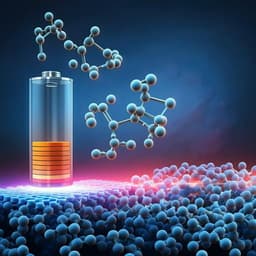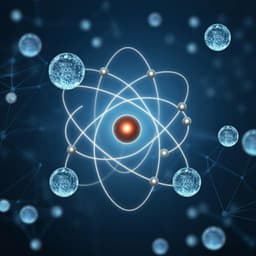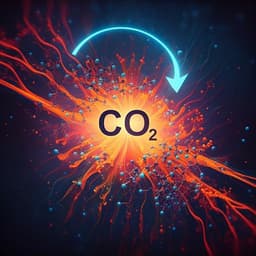
Chemistry
Ampere-level current density ammonia electrochemical synthesis using CuCo nanosheets simulating nitrite reductase bifunctional nature
J. Fang, Q. Zheng, et al.
Discover how a bio-inspired CuCo nanosheet electrocatalyst mimics the bifunctional nature of copper-type nitrite reductase, achieving remarkable efficiency in converting nitrate to ammonia. This innovative research, conducted by Jia-Yi Fang and team, reveals a strategic synergy between copper and cobalt that enhances selectivity and yield.
~3 min • Beginner • English
Introduction
Nitrate (NO3−) contamination in industrial and agricultural wastewater poses risks to human health and ecosystems, particularly via partial conversion to nitrite (NO2−). Electrocatalytic reduction of NO3− to NH3 powered by renewable electricity is a promising, sustainable complement to the energy- and carbon-intensive Haber–Bosch process. The research question is how to design an electrocatalyst that simultaneously achieves high activity (current density), high selectivity (Faradaic efficiency to NH3), and low overpotential for NO3− reduction to NH3. Inspired by the bifunctional architecture of copper-type nitrite reductases (Cu-NIRs), which employ separate Cu centers for electron donation (T1Cu) and substrate binding/catalysis (T2Cu), the study hypothesizes that a bimetallic Cu–Co catalyst can mimic this bifunctionality: Co providing proton/electron donors and Cu providing strong NOx adsorption/activation, thereby balancing *H and *NO3 coverage to enhance both rate and selectivity.
Literature Review
Biological NO3− reduction involves sequential steps mediated by nitrate reductases and nitrite reductases (NIRs), with Cu-type NIRs featuring distinct Cu centers (T1 and T2) that coordinate electron transfer and substrate activation. Prior electrocatalytic studies indicated that moderate hydrogen adsorption (*H) can facilitate NOx hydrogenation to NH3 and suppress competing HER. Recent reports on Cu–Co sulfide systems suggested tandem pathways with NO2− formed on Cu phases and further reduced on Co phases, but the role of *H and alloy electronic structure remained unclear. Other alloy systems (e.g., Cu–Ni) demonstrated tuning intermediate adsorption to enhance activity. Overall, literature underscores the importance of balancing NO3−/NOx adsorption with controlled *H availability, motivating the present Cu–Co alloy nanosheet catalyst that emulates enzymatic bifunctionality and probes mechanistic details via in situ spectroscopy and DFT.
Methodology
Catalyst synthesis: Cu–Co bimetallics (CuxCoy) and monometallic Cu, Co were prepared by electrodeposition onto pretreated Ni foam (0.5 cm × 0.5 cm) in a two-electrode setup (Pt counter, Ni foam working). Deposition conditions: 50 mA cm−2 for 300 s in 50 mL electrolyte containing 0.015 M trisodium citrate and mixed 50 mM metal salts (CuSO4 and CoSO4) with feed ratios (CuSO4:CoSO4) of 60:40, 45:55, and 10:90 to obtain Cu65Co35, Cu50Co50, and Cu15Co85, respectively. Pure Cu or Co used only the corresponding single salt. Post-deposition rinsing and Ar drying were applied. Estimated catalyst loading on Ni foam was 5 mg cm−2.
Characterization: SEM with EDS for morphology/composition; AFM for nanosheet thickness; HRTEM for lattice spacing; XRD for alloy formation (peak shifts indicating lattice contraction); XPS for electronic states (Cu 2p, Co 2p shifts evidencing charge redistribution); XAS (XANES) at Cu and Co K-edges for electron density transfer (edge shifts); Bader charge analysis and model visualization supported electron redistribution in CuCo(111).
Electrochemical testing: Three-electrode configurations in an H-type cell separated by Nafion 117 (pretreated), with magnetic stirring at 1000 rpm. Electrolyte: typically 1 M KOH with 100 mM KNO3 (30 mL). Reference: Hg/HgO (1 M KOH), counter: Pt plate; potentials converted to RHE. Catalysts were pre-reduced at −0.2 V (vs RHE) for 600 s to remove surface oxides. LSV was measured at 1 mV s−1 (80% iR-corrected) for activity screening. Steady-state potentiostatic electrolysis was used to quantify products, with fresh electrolyte feed to maintain NO3− concentration. Rotating disk electrode (RDE) studies: inks prepared from catalyst powder (0.25 mg cm−2 loading), LSV at scan 10 mV s−1, speeds 100–625 rpm to construct Koutecký–Levich plots and deduce electron transfer numbers.
Kinetics and EIS: Tafel slopes extracted in regions S1 (NO3− to NO2−) and S2 (NO2− to NH3); EIS for charge-transfer resistance. K–L analysis determined electron numbers and potential-dependent pathways.
Product analysis: NH3 quantified by Nessler reagent method (absorbance at 420 nm) with calibration in 1 M KOH; cross-validated by 1H NMR (protonation with H2SO4 and internal standard maleic acid). NO3− and NO2− quantified by ion chromatography. Gas products (H2, N2, NO, NO2, N2O, NH3(g)) analyzed by gas chromatography and online electrochemical mass spectrometry; no N2 detected and negligible stripped NH3 observed. Faradaic efficiency and yield rates computed from standard formulae using measured concentrations, charge, electrode area, and catalyst mass.
In situ spectroscopy: Electrochemical thin-layer in situ FTIR (CaF2 window, ~10 µm layer, MCT-A detector) with reference at 0.4 V and steps to −0.2 V; spectra reported as ΔR/R. ATR-FTIR with gold-plated Si prism, incidence ~65°, reference at 0.5 V, stepped to −0.4 V. SHINERS: Au electrode modified with catalyst ink and shell-isolated Au nanoparticles; 637.8 nm excitation, spectra acquired under potential control. EPR: DMPO spin trapping for hydrogen radicals under potentiostatic electrolysis.
Computational methods: DFT using VASP with PAW and PBE-GGA, 600 eV cutoff, energy/force convergence of 1×10−5 eV and 0.01 eV Å−1. Slab models: 2×2 supercells of Cu(111), Co(111), and CuCo(111) with three layers and 15 Å vacuum; top layer relaxed, bottom two fixed. K-point meshes 3×3×1 for slabs, 8×8×8 for bulk. Spin polarization applied for Co and CuCo surfaces; dipole corrections in z. Free energy diagrams for NO3RR intermediates and HER at −0.2 V vs RHE constructed to identify thermodynamics and rate-determining steps.
Key Findings
- Cu–Co alloying forms micro-pine structures with nanosheet features (~10 nm thick) and homogeneous Cu/Co distribution. XRD peak shifts and HRTEM lattice contraction (Cu(111) from 0.212 to 0.208 nm) indicate alloying. XPS/XANES/Bader analyses show electron redistribution from Co to Cu, tuning d-band towards the Fermi level.
- Activity metrics: At −0.2 V vs RHE, Cu50Co50 achieves ampere-level current density with 100 ± 1% Faradaic efficiency to NH3 and jNH3 = 1035 mA cm−2, corresponding to NH3 production rate of 4.8 mmol cm−2 h−1; estimated mass activity Yieldmass-NH3 ≈ 960 mmol gcat−1 h−1 (reported at 0.2 V). Potential window for FE_NH3 > 90% spans −0.1 to −0.4 V.
- Kinetics: Overpotentials at 10 mA cm−2 (E0 = 0.69 V): η10 for Cu50Co50 = 498 mV, Cu = 503 mV, Co = 690 mV. LSV shows two peaks: S1 (~0.08 V) assigned to NO3− → NO2− (2 e−), S2 assigned to NO2− → NH3 (6 e−). Cu50Co50 exhibits a 67 mV positive shift in S2 vs Cu, signifying facilitated NO2− hydrogenation. K–L analysis: Cu transitions from 2e− at −0.1 V to 6e− at −0.25 V, whereas Cu50Co50 exhibits direct 8e− transfer between S1 and S2, indicating simultaneous promotion of both steps. Tafel slopes: in S1 region, Cu50Co50 205.75 vs Cu 232.43 mV dec−1; in S2 region, Cu50Co50 148.95 vs Cu 229.75 mV dec−1; Co shows 94.24 mV dec−1 but at more negative potentials (≈95 mV shift).
- Composition dependence: At 0 V, FE_NH3 and jNH3 show a volcano vs Cu/Co ratio; Cu50Co50 yields jNH3 ≈ 347 mA cm−2 with FE_NH3 ≈ 88%, outperforming Cu (34 mA cm−2, 32% FE_NH3) and Co (21 mA cm−2, 84% FE_NH3). NO2−/NH3 product ratio decreases dramatically with increasing Co fraction (from ~7 to ~0.6), indicating enhanced NO2− hydrogenation with Co incorporation. ECSA-normalized activity is highest for Cu50Co50, indicating superior intrinsic activity.
- Selectivity and stability: No N2 detected by GC/OEMS; negligible stripped NH3. FE_NH3 reaches 100 ± 1% at −0.2 V. Cu50Co50 maintains FE_NH3 > 95% across NO3− concentrations 1–100 mM at −0.1 V; in neutral electrolyte (0.1 M KNO3 + 0.5 M K2SO4) at −0.2 V, FE_NH3 > 90% and higher current density than monometallics. Batch removal (100 mM NO3−, −0.1 V): 99.5% nitrate removal after 10 h, FE_NH3 96%, final NO3− 31 ppm (< WHO 50 ppm limit). Over 10 consecutive 1 h cycles at −0.2 V, FE_NH3 remains > 90%; minor yield decay attributed to nanosheet agglomeration.
- Mechanistic insights: In situ FTIR detects NO3− consumption (1392, 1354 cm−1), NO2 formation (1236 cm−1), and NH2OH intermediate (~1110 cm−1); water-related band (~1638 cm−1) indicates proton source. SHINERS evidences adsorbed nitrate/nitro configurations, HNO (~1540 cm−1), and NH3 bending (~1591 cm−1). Cu shows additional ~800 cm−1 NO2 bending, consistent with NO2 accumulation; Co shows weak intermediate adsorption due to strong *H coverage. Proposed pathway: NO3− → *NO3 → *NO2 → *NO → *NOH → *NH2OH → NH3. DFT free-energy analysis at −0.2 V identifies initial *NO3 adsorption as RDS; ΔGads(*NO3) is lowest on CuCo(111) (0.17 eV) vs Co(111) (0.34 eV) and Cu(111) (0.61 eV). On Co, strong *H adsorption limits *NO3 coverage (HER competition), while CuCo balances *H and *NO3 adsorption, lowering barriers for both adsorption and hydrogenation steps.
Discussion
The study demonstrates that emulating the bifunctional architecture of Cu-type nitrite reductase with a Cu–Co alloy nanosheet catalyst effectively reconciles the competing requirements of strong NOx adsorption/activation and sufficient, but not excessive, *H availability. Cu sites preferentially adsorb NO3−/NOx intermediates, while Co sites supply adsorbed hydrogen for hydrogenation, and their electronic interaction (electron transfer from Co to Cu) tunes the surface adsorption energetics. Electrochemical analyses (K–L, Tafel, EIS) show enhanced kinetics for both NO3− to NO2− and NO2− to NH3 steps on Cu50Co50, including direct 8-electron pathways under certain potentials. In situ FTIR and SHINERS corroborate the sequence of intermediates (NO3−, NO2−, NH2OH, HNO, NH3) and reveal that Cu alone accumulates NO2− while Co alone suffers from excessive *H coverage, reducing NOx adsorption. DFT quantifies the reduced free-energy barrier for the rate-determining *NO3 adsorption on CuCo(111) and rationalizes the suppression of HER competition via moderated *H binding relative to Co. Together, these findings validate the initial hypothesis that a Cu–Co bifunctional surface can simultaneously maximize activity and selectivity for NO3−-to-NH3 conversion, and they highlight the importance of balancing *H and *NO3 coverage for optimal performance.
Conclusion
A Cu–Co alloy nanosheet catalyst that mimics the bifunctional Cu centers of nitrite reductase achieves near-quantitative selectivity and high activity for electrocatalytic nitrate reduction to ammonia. Cu50Co50 delivers 100 ± 1% FE to NH3 at an ampere-level current density of 1035 mA cm−2 at −0.2 V, with an NH3 production rate of 4.8 mmol cm−2 h−1 and an estimated mass activity of ~960 mmol gcat−1 h−1. The catalyst maintains >90% FE over a wide potential window (−0.1 to −0.4 V), exhibits robust performance across nitrate concentrations and in neutral media, and enables 99.5% nitrate removal to below WHO drinking water limits in batch. Combined in situ FTIR/SHINERS and DFT reveal that electronic interactions between Cu and Co lower the barrier for *NO3 adsorption and provide balanced *H availability to drive hydrogenation, explaining the superior kinetics and selectivity. Future work should focus on scaling up electrode configurations, mitigating morphological agglomeration, optimizing mass transport, and integrating ammonia recovery processes to translate these laboratory-scale advances toward practical, industrial applications.
Limitations
- The reported performance is demonstrated at laboratory scale; pilot-scale validation and system-level energy/efficiency analyses are needed for industrial translation.
- Estimated mass activity may be slightly underestimated due to hydrogen evolution during electrodeposition affecting mass loading estimation.
- Some activity is diffusion-limited under certain conditions, necessitating optimized reactor designs and electrolyte management.
- Stability tests showed nanosheet agglomeration over repeated cycles, suggesting a need for morphology stabilization strategies.
- No N2 was detected, but comprehensive nitrogen balance under various operating conditions and long-term operation should be further assessed.
Related Publications
Explore these studies to deepen your understanding of the subject.







